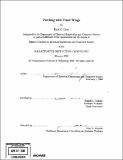Perching with fixed wings
Author(s)
Cory, Rick E. (Rick Efren)
DownloadFull printable version (9.467Mb)
Other Contributors
Massachusetts Institute of Technology. Dept. of Electrical Engineering and Computer Science.
Advisor
Russell L. Tedrake.
Terms of use
Metadata
Show full item recordAbstract
Human pilots have the extraordinary ability to remotely maneuver small Unmanned Aerial Vehicles (UAVs) far outside the flight envelope of conventional autopilots. Given the tremendous thrust-to-weight ratio available on these small machines [1, 2], linear control approaches have recently produced impressive demonstrations that come close to matching this agility for a certain class of aerobatic maneuvers where the rotor or propeller forces dominate the dynamics of the aircraft [3, 4, 5]. However, as our flying machines scale down to smaller sizes (e.g. Micro Aerial Vehicles) operating at low Reynold's numbers, viscous forces dominate propeller thrust [6, 7, 8], causing classical control (and design) techniques to fail. These new technologies will require a different approach to control, where the control system will need to reason about the long term and time dependent effects of the unsteady fluid dynamics on the response of the vehicle. Perching is representative of a large class of control problems for aerobatics that requires and agile and robust control system with the capability of planning well into the future. Our experimental paradigm along with the simplicity of the problem structure has allowed us to study the problem at the most fundamental level. This thesis presents methods and results for identifying an aerodynamic model of a small glider at very high angles-of-attack using tools from supervised machine learning and system identification. Our model then serves as a benchmark platform for studying control of perching using an optimal control framework, namely reinforcement learning. Our results indicate that a compact parameterization of the control is sufficient to successfully execute the task in simulation.
Description
Thesis (S.M.)--Massachusetts Institute of Technology, Dept. of Electrical Engineering and Computer Science, 2008. Includes bibliographical references (leaves 43-46).
Date issued
2008Department
Massachusetts Institute of Technology. Department of Electrical Engineering and Computer SciencePublisher
Massachusetts Institute of Technology
Keywords
Electrical Engineering and Computer Science.